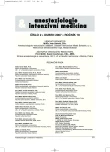Oxygen toxicity in the course of hyperbaric oxygenotherapy
Authors:
M. Hájek
Authors‘ workplace:
Centrum hyperbarické oxygenoterapie, Anesteziologicko-resuscitační oddělení, Městská nemocnice Ostrava
Published in:
Anest. intenziv. Med., 18, 2007, č. 2, s. 96-102
Category:
Intensive Care Medicine - Original Paper
Overview
Objective:
Hyperbaric oxygen treatment is based on breathing pure oxygen under pressure higher than the ambient pressure. Signs of toxicity can occur due to the presence of oxygen and nitrogen reactive substances during exposure to high doses of oxygen.
Aim of study:
To find the incidence of oxygen toxicity in patients treated in our centre in 1994–2005.
Design:
Observational retrospective study.
Results:
4,164 patients underwent total 48,992 treatment sessions in the period studied. Thirteen cases of toxicity occurred in 7 patients. The most dramatic symptom of oxygen CNS toxicity – hyperoxia-induced seizures – were observed in 4 patients (0.008%). The relation between hyperoxia-induced seizures and treatment pressure at different time periods was analysed and compared with the results of our previous study from 1984.
Conclusion:
Hyperbaric oxygen treatment is a safe and well tolerated method with a low incidence of CNS toxicity.The incidence of hyperoxia-induced seizures presented in our paper is almost the lowest of recently published studies. No injury or permanent sequelae were observed in relation to hyperoxia-induced seizures.
Key words:
hyperbaric oxygenation – hyperoxia – toxic actions – CNS – pulmonary function – seizures
Labels
Anaesthesiology, Resuscitation and Inten Intensive Care MedicineArticle was published in
Anaesthesiology and Intensive Care Medicine

2007 Issue 2
Most read in this issue
- Oxygen toxicity in the course of hyperbaric oxygenotherapy
- Postintubation tracheal rupture – a case report
- Anaesthesiology and resuscitation in The Central Army Hospital in Prague (1948–1972)
- The benefits of BIS monitoring during sevoflurane anaesthesia in children
